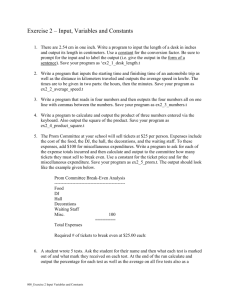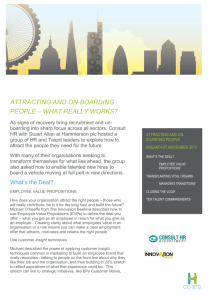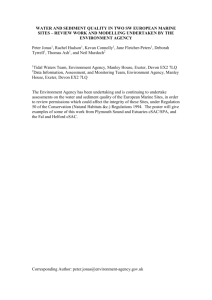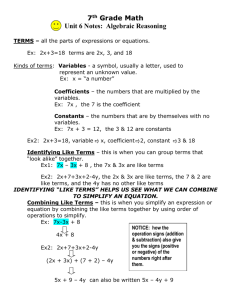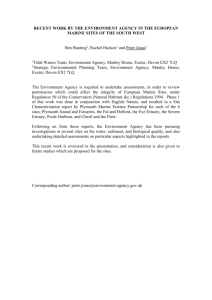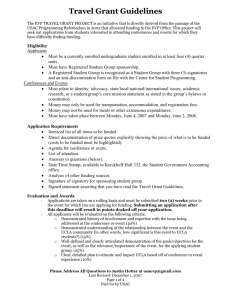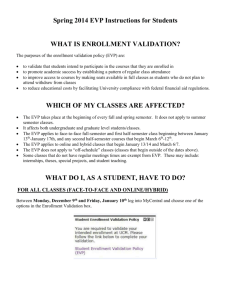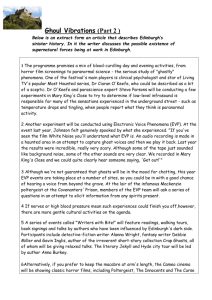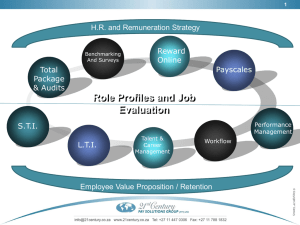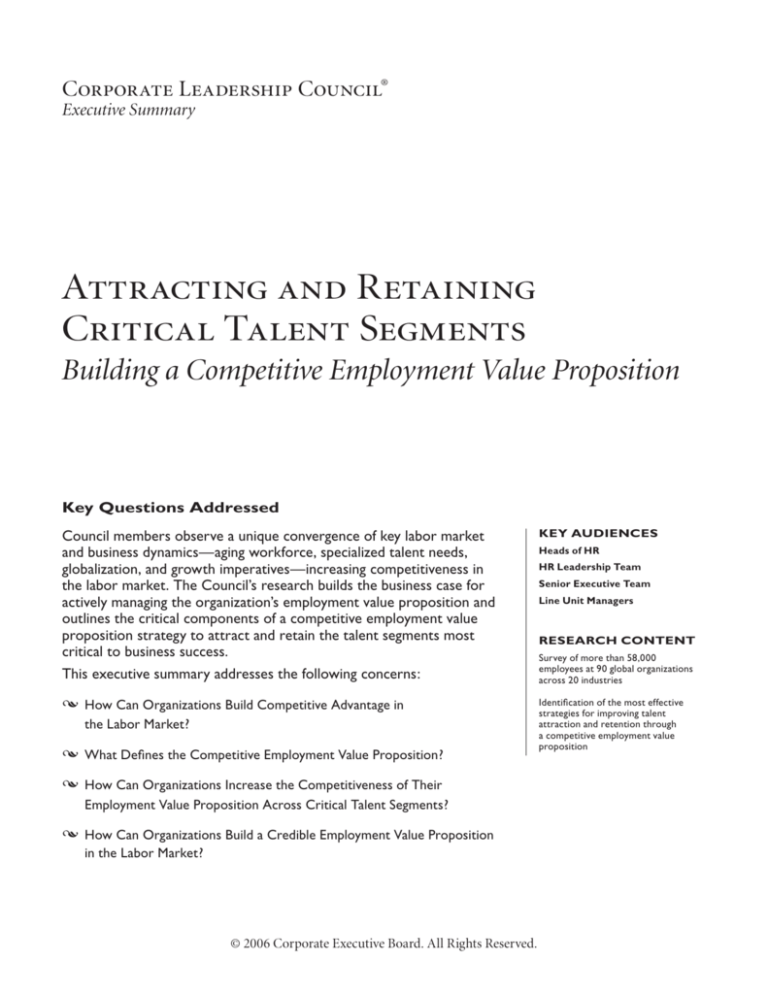
Corporate Leadership Council®
Executive Summary
Attracting and Retaining
Critical Talent Segments
Building a Competitive Employment Value Proposition
Key Questions Addressed
Council members observe a unique convergence of key labor market
and business dynamics—aging workforce, specialized talent needs,
globalization, and growth imperatives—increasing competitiveness in
the labor market. The Council’s research builds the business case for
actively managing the organization’s employment value proposition and
outlines the critical components of a competitive employment value
proposition strategy to attract and retain the talent segments most
critical to business success.
This executive summary addresses the following concerns:
How Can Organizations Build Competitive Advantage in
the Labor Market?
What Defines the Competitive Employment Value Proposition?
How Can Organizations Increase the Competitiveness of Their
Employment Value Proposition Across Critical Talent Segments?
How Can Organizations Build a Credible Employment Value Proposition
in the Labor Market?
© 2006 Corporate Executive Board. All Rights Reserved.
KEY AUDIENCES
Heads of HR
HR Leadership Team
Senior Executive Team
Line Unit Managers
RESEARCH CONTENT
Survey of more than 58,000
employees at 90 global organizations
across 20 industries
Identification of the most effective
strategies for improving talent
attraction and retention through
a competitive employment value
proposition
Corporate Leadership Council
Project Manager
Christoffer Ellehuus
Corporate Leadership Council
Corporate Executive Board
2000 Pennsylvania Avenue NW
Washington, DC 20006
Telephone: +1-202-777-5000
Fax: +1-202-777-5100
The Corporate Executive Board Company (UK) Ltd.
Victoria House
Fourth Floor
37–63 Southampton Row
Bloomsbury Square
London WC1B 4DR
United Kingdom
Telephone: +44-(0)20-7632-6000
Fax: +44-(0)20-7632-6001
www.clc.executiveboard.com
Consultants
Thomas Bedington
Warren Howlett
Stephanie Tarant
Analysts
Brad Adams
Pippa Rowson
Practice Managers
Brian Kropp
Scott Lund
Managing Directors
Nicholas Connolly
Jean Martin-Weinstein
Executive Director
Conrad Schmidt
General Manager
Peter Freire
Creative Solutions Group
Senior Graphic Design Specialist
Christie Drake
Publications Editor
Sandy Kolman
Note to Members
This project was researched and written to fulfi ll the research requests of several members of the Corporate Executive Board and as a result may not satisfy the
information needs of all member companies. The Corporate Executive Board encourages members who have additional questions about this topic to contact
the Board staff for further discussion. Descriptions or viewpoints contained herein regarding organizations profi led in this report do not necessarily reflect
the policies or viewpoints of those organizations.
Confidentiality of Findings
This document has been prepared by the Corporate Executive Board for the exclusive use of its members. It contains valuable proprietary information belonging
to the Corporate Executive Board and each member should make it available only to those employees who require such access in order to learn from the
material provided herein and who undertake not to disclose it to third parties. In the event that you are unwilling to assume this confidentiality obligation,
please return this document and all copies in your possession promptly to the Corporate Executive Board.
Legal Caveat
The Corporate Leadership Council has worked to ensure the accuracy of the information it provides to its members. This report relies upon data obtained from
many sources, however, and the Corporate Leadership Council cannot guarantee the accuracy of the information or its analysis in all cases. Furthermore, the
Corporate Leadership Council is not engaged in rendering legal, accounting, or other professional services. Its reports should not be construed as professional
advice on any particular set of facts or circumstances. Members requiring such services are advised to consult an appropriate professional. Neither the Corporate
Executive Board nor its programs are responsible for any claims or losses that may arise from a) any errors or omissions in their reports, whether caused by
the Corporate Leadership Council or its sources, or b) reliance upon any recommendation made by the Corporate Leadership Council.
© 2006 Corporate Executive Board. All Rights Reserved.
CLC16H6BAL
4
Attracting and Retaining Critical Talent Segments
Executive Summary
5
Summary of Findings
How Can Organizations Build Competitive Advantage in the Labor Market?
• The Employment Value Proposition (EVP) Is Critical to Talent Attraction and Commitment.
Constructing and delivering an effective employment value proposition allows an organization to
source more deeply within the labor market—increasing its access to more passive candidates. It
also improves the commitment of new hires by up to 29%.
• Improving EVP Attractiveness Reduces New-Hire Compensation Premiums by up to 50%.
When candidates in the labor market view an organization’s EVP as attractive, they demand
less of a compensation premium when deciding to join. Specifically, EVPs that are viewed as
unattractive require a 21% premium to attract candidates, while attractive EVPs require only an
11% premium.
What Defines the Competitive Employment Value Proposition?
• A Core Set of 7 Attributes Are Universally Important for Driving Attraction and Commitment.
The starting point for any organization’s EVP should be the seven core elements that provide, on
average, 60% of the attraction and engagement benefit across all major talent segments.
• The Competitive EVP Must Be Differentiated from Competitors’ and Strategically Relevant. A
competitive EVP builds upon market realities and leverages the organization’s strengths relative
to competitors in the areas most important to employees. The EVP must also align with the
organization’s current capabilities and longer-term strategic objectives to succeed.
How Can Organizations Increase the Competitiveness of Their Employment Value Proposition Across
Critical Talent Segments?
• The Winning EVP Addresses Geographic Variation in the EVP Preferences of Critical Talent
Segments. Geographic differences account for 72% of the variation in EVP preferences, followed
by variation across employee levels. Segmentation based on function, gender, or ethnicity is
unlikely to generate sufficient returns.
• Talent Segments in Emerging Markets Have Unique EVP Preferences That Must Be Prioritized.
Contrary to the developed economies, there is no universal EVP for the emerging economies.
Country-specific analysis shows that compensation is relatively less important to attract talent in
India while company growth and innovation are more important. In China, a disproportionately
high importance is placed on development opportunities.
How Can Organizations Build a Credible Employment Value Proposition in the Labor Market?
• A Successful Labor Market Communication Strategy Emphasizes Organizational Reality,
Message Consistency, and Self-Assessment. Organizations can increase new-hire commitment
up to 27% by ensuring that the recruiting process accurately reflects the realities of the work
environment and allows candidates to judge their fit with the organization. To be credible, all
communication of the EVP must be consistent.
• Three Keys to Increasing the Number of Employees Advocating for the Organization Are
Trust, Flexibility, and Organizational Values. Employees are the most trusted communication
channel of potential new hires, but only 24% of employees would recommend their organization.
Addressing these key issues can increase employees’ likelihood of advocating the organization in
the labor market by up to 47%.
Source: Corporate Leadership Council research.
6
Attracting and Retaining Critical Talent Segments
The Employment Value Proposition (EVP) Is a Solution to the Talent Shortage. Based on data collected from
its 2006 Employment Value Proposition Survey, the Council has examined the effectiveness of 38 unique EVP
attributes at driving attraction and commitment of talent. The results from the research demonstrate that
effective management of the EVP can increase the size of the available talent pool, as well as candidates’ fit with
the organization. Once candidates join the organization, an effective EVP will also improve their effort levels
and performance and reduce turnover.
The Employment Value Proposition—
A Key to Attraction and Commitment
The Employment Value Proposition (EVP) drives
attraction and commitment in the labor market
Attraction
EVP Attributes
Commitment
• Increases the size of
the available talent pool
The Five EVP Categories*
• Improves employee effort
level and performance
• Increases fit between
organization and the
candidate
• Improves retention
Rewards
Opportunity
Organization
Work
People
EVP
Attractiveness
Index
Employment Value
Proposition
The set of attributes that the labor
market and employees perceive as the
value they gain through employment
in an organization
Commitment
CLC’s Employment Value Proposition Survey
The Corporate Leadership Council surveyed more than 58,000 new hires and tenured
employees from 90 organizations across 34 countries and 20 industries and measured the
impact of 38 unique EVP attributes on candidate attraction and employee commitment.
* The Council assessed in total 38 EVP attributes related to each of the fi ve EVP categories.
Source: Corporate Leadership Council research.
Executive Summary
How Can Organizations Build Competitive Advantage in the Labor Market?
The Employment Value Proposition (EVP) Is Critical to Talent Attraction and Commitment. Constructing
and delivering an effective employment value proposition allows an organization to source more deeply within
the labor market—increasing its access to more passive candidates. It also improves the commitment of new
hires by up to 29%.
Improving Talent Competitiveness
Effective management of the EVP enables organizations to
source from a deeper pool of talent from the labor market…
Degree of Activity in the Labor Market
Organizations with managed
EVPs are able to effectively
source from more than 60%
of the labor market…
12%
Distribution
of Labor
Market by
Degree of
Job-Seeking
Activity1
…while organizations with
unmanaged EVPs are able
to source from only 40%
of the labor market.
6%
Managed EVP Unmanaged EVP
0%
0
25
50
Very Passive Candidates
75
100
Very Active Candidates
…and ensure higher levels of commitment from newly hired employees
Commitment Levels, Less Than One Month of Tenure
Poor Versus Excellent EVP Delivery
38%
40%
Percentage
of Employees
Displaying
20%
High Levels of
Commitment2
When organizations
effectively deliver on the EVP,
new employees arrive with
higher levels of commitment.
= 29%
9%
0%
Poor
Excellent
EVP Delivery3
1
Respondents are measured on a scale of 1 to 100 based on how active they were in the labor market before they were hired by
their current organization. A score of 100 indicates that respondents were very active, and a score of 1 indicates that respondents
were very passive in their job-search behavior.
2
High levels of commitment are defi ned as employees whose commitment scores are higher than 90 on a 100-point scale.
3
Poor EVP delivery is defi ned by employees who have an EVP delivery of 4 or lower on a 7-point scale. Excellent delivery is defi ned
as an average score across all attributes of 6 or more.
Source: Corporate Leadership Council,
Employment Value Proposition Survey:
Corporate Leadership Council research.
7
8
Attracting and Retaining Critical Talent Segments
How Can Organizations Build Competitive Advantage in the Labor Market?
Improving EVP Attractiveness Reduces New-Hire Compensation Premiums by up to 50%. When candidates
in the labor market view an organization’s EVP as attractive, they demand less of a compensation premium
when deciding to join. Specifically, EVPs that are viewed as unattractive require a 21% premium to attract
candidates, while attractive EVPs require only an 11% premium.
Decreasing Compensation Costs
An attractive employment value proposition decreases
the compensation premium required to attract candidates
The Monetary Benefits of Increasing Attractiveness
Only an 11% increase
in compensation is
needed to attract
candidates who feel the
EVP is attractive…
21%
…while a 21% premium
is needed to lure
candidates who feel the
EVP is unattractive.
16%
Average
Compensation
Increase When
Changing
Organizations
11%
Increase in
Compensation for
Candidates Who
Think the EVP Is
Attractive
Average Increase
in Compensation
Increase in
Compensation for
Candidates Who
Think the EVP Is
Unattractive
Doing the Math
Assuming an organization hires 500 people per year at an average salary of $50,000, the
additional compensation premium that they pay by being relatively unattractive in the
labor market is $2.6 million per year in base compensation.
Note: Respondents’ compensation level in their previous job is compared against compensation
in their current job. Analysis was conducted to ensure that these fi ndings hold for both
vertical and horizontal movements.
Source: Corporate Leadership Council, Employment
Value Proposition Survey: Corporate
Leadership Council research.
Executive Summary
9
What Defines the Competitive Employment Value Proposition?
A Core Set of 7 Attributes Are Universally Important for Driving Attraction and Commitment. The starting
point for any organization’s EVP should be the seven core elements that provide, on average, 60% of the
attraction and engagement benefit across all major talent segments.
Defining the “Core” EVP for the Labor Market
Seven attributes—and five additional attributes for developed
economies—provide the majority of benefit for driving attraction
and commitment across all major talent segments
Core and Developed Economies’ EVP Attributes
Across All Major Segments
These attributes improve both
the quantity of employees
attracted and the quality of
their commitment levels.
Development
Opportunities
Future Career
Opportunities
Respect
Compensation
Organizational
Stability
Certain attributes become
uniquely important across
all developed economies.1
Location
Work–Life
Balance
Manager Quality
Collegial Work
Environment
Meritocracy
Ethics
Top Drivers: Attraction
People
Management
Top Drivers: Commitment
EVP Return2 by Strategy
Australia
Australia
Canada
Canada
France
France
Germany
Germany
Japan
Japan
United
United
Kingdom
Kingdom
United
United
States
States
China
China
India
India
Benefi
BenefitstsReceived
Received
by
byFocus
Focuson
on
Seven
SevenAttributes
Attributes
ininUniversal
Universal Core
Core
EVP EVP
59%
59%
60%
60%
58%
58%
58%
58%
54%
54%
58%
58%
60%
60%
60%
60%
56%
56%
Additional
Additional
Benefi
BenefittofofAdding
Adding
Five
FiveDevelopedDeveloped
Economy
Economy
Attributes
Attributes
+23%
+23%
+19%
+19%
+16%
+16%
+12%
+12%
+17%
+17%
+22%
+22%
+19%
+19%
+3%
+3%
+4%
+4%
Developed Economies
Note: Defi ning the Core: Core attraction attributes are rated in the top 13 in importance for more than 60% of respondents across all
talent segments (e.g., geography, function). 2 Core commitment attributes have a greater than 30% impact on commitment for all
talent segments. Some non-core attributes are important for particular talent segments
1
Analysis includes respondents from: Australia, Canada, France, Germany, Japan, New Zealand, United Kingdom, and the United States.
2
The percentage indicated in the table is the average return of the compensation premium, labor market sourcing, and commitment
benefi t. For example, by focusing on the core attributes in Australia, organizations are able to obtain 59% of the average of the
compensation premium, sourcing benefi t, and commitment benefi t.
Source: Corporate Leadership Council,
Employment Value Proposition
Survey; Corporate Leadership
Council research.
10
Attracting and Retaining Critical Talent Segments
Defining the Differentiated Employment Value Proposition—Employment Value
Proposition Redesign
Scotiabank redefines its EVP by first assessing its current strengths and weaknesses
compared to key labor market competitors, then identifying aspects of the EVP that best
align with the organization’s strategic objectives and culture, and finally prioritizing HR
investments in support of the new EVP.
Creating the Competitive
Employment Value Proposition
Scotiabank identifies EVP attributes that best align with strategic priorities
and provide the best opportunities for competitive differentiation
Employment Value Proposition Decision Criteria
Perceived as
Current Strength
by Employees and
Candidates
Relevance
to Strategic
Objectives
1. Recognizes
and Rewards
Performance
Low
High
Medium
High
Critical to strategy
2. Strong Managers
Low
Medium
Low
Medium
Low opportunity
for differentiation
3. Fun, Hardworking
Colleagues
High
Medium
High
Low
Low strategic
relevance
4. Successful
Organization
High
High
High
Low
Competitive strength
5. Many Career
Opportunities
High
Medium
Low
Medium
Low opportunity
for differentiation
6. Strong Relationships
High
High
High
Low
Competitive strength
7. Cares About People
High
Low
Medium
Low
Low strategic
relevance
Potential Value
Proposition Aspects
Opportunity
Implementation
for Competitive
Cost
Differentiation
Executive Steering Group
Background
• Cross-organizational executive
steering group
• Chaired by the head of HR
• Convened throughout the
process of creating the EVP to
provide guidance and support,
and for the project team to
secure executive buy-in.
SVP, Public Affairs
EVP
Marketing
EVP, HR
(Chairman)
Six SVPs, Business Units
EVP Focus Areas
“Together”
(Brand Theme)
• We recognize and
reward performance
• We are a successful
company
• We believe in the value
of strong relationships
Objectives
• Provide business line perspective to
ensure the EVP is strategically and
globally relevant
• Support project team from a capital
investment perspective and overcome
internal barriers
• Provide subject-matter expertise (i.e.,
head of marketing, head of public
affairs) and strategic counsel
Key Insight
A competitive EVP builds upon market realities and leverages the organization’s strengths
relative to competitors in the areas most important to employees. The EVP must also align
with the organization’s current capabilities and longer-term strategic objectives to succeed.
Source: The Bank of Nova Scotia; Corporate Leadership Council research.
Executive Summary
11
How Can Organizations Increase the Competitiveness of Their Employment Value Proposition Across Critical
Talent Segments?
The Winning EVP Addresses Geographic Variation in the EVP Preferences of Critical Talent Segments.
Geographic differences account for 72% of the variation in EVP preferences, followed by variation across
employee levels. Segmentation based on function, gender, or ethnicity is unlikely to generate sufficient returns.
Geography Is the Main Driver of Variation
Level of Variation in Preferences1 and Differentiation Across Employee Segments
Large Differences2
EVP preferences vary
significantly by geography.
Moderate Differences
Functions show only moderate
variations in EVP preferences.
ty 3
i ci
hn
Et
m
a
M le
ale
Se
ag
an
M
Fe
er
nio s
rE
xe
23
cu
–2
tiv
9
es
50 Ye
– 5 ar
O
9
Ye lds
a
En
rO
gin
ld
ee
s
r in
H
um
g
an
M
R
an eso
uf
ur
a
Re c tu ces
r in
ta
il
g
Sa
les
es
at
St
te
d
Ki
ni
U
ni
U
In
di
er
a
te
d
an
y
m
ce
G
an
in
a
Fr
Ch
Ca
na
da
ng
do
m
Minimal Differences
Importance: Are there
significant differences
in which EVP attributes
drive attraction and
commitment?
Awareness: Are there
significant segment
differences in the way
EVP information is
consumed?
Geography
Level
Age
Function
Gender Ethnicity
Implications
• Organizations need to strongly consider how they can vary their EVP
across geographies.
• Segmentation based on function, gender, or ethnicity is unlikely to generate returns.
1
The level of variation in EVP content and competitiveness by segment was assessed by determining the number
of attributes that are substantially different from the aggregate population. Content variation was determined
by assessing the extent to which EVP preferences across the 38 attributes were substantially different for a given
segment compared to the benchmark. Competitive variation was determined according to whether a given
segment’s level of awareness of the attributes was substantially different across the 38 attributes.
2
Large differences indicate segments where more than six statistically significant differences occur. Moderate
differences are situations where three to six significant differences occur. Minimal differences are situations with
fewer than three statistically significant differences.
3
The following ethnicities were tested: Asian, Black or Black African, Hispanic, Middle Eastern, Native American,
Pacific Islander, and Western or Eastern European.
Source: Corporate Leadership Council, Employment
Value Proposition Survey; Corporate
Leadership Council research.
12
Attracting and Retaining Critical Talent Segments
How Can Organizations Increase the Competitiveness of Their Employment Value Proposition Across Critical
Talent Segments?
Talent Segments in Emerging Markets Have Unique EVP Preferences That Must Be Prioritized. Contrary
to the developed economies, there is no universal EVP for the emerging economies. Country-specific analysis
shows that compensation is relatively less important to attract talent in India while company growth and
innovation are more important. In China, a disproportionately high importance is placed on development
opportunities.
Attracting Talent in Emerging Markets
The labor market in India will trade off compensation for innovation and high growth…
Difference in Attraction, by Attributes
India Versus United States
60%
Compensation is relatively less important
in India while growth rate and innovation
are more important for attraction.
58%
Percentage of
Respondents
Rating in Top 30%
Five
United States
India
35%
21%
7%
20%
16%
6%
5%
0%
Compensation
Innovation
Growth Rate
Market Position
…while the labor market in China is significantly
more focused on development opportunities
Difference in Attraction, by Attributes
China Versus United States
60%
58%
Significantly more
importance is placed on
development opportunities.
59%
42%
Percentage of
Respondents
Rating in Top 30%
Five
United States
China
39%
23%
18%
0%
Compensation
Development
Opportunities
Health Benefi ts
Two Unique Cases
Unlike the common attributes observed across developed economies, there are no attributes that
consistently drive attraction and commitment across both India and China.
Note: For this segment, the Council assessed the relative importance of all the EVP attributes for driving attraction and commitment
compared to the benchmark to determine which attributes are most important to include in EVP segmentation strategies.
The most important deviations from the benchmark are shown above.
Each bar of the graphic represents the percentage of respondents reporting a given attribute as top fi ve in importance when
evaluating an organization as a potential employer for each segment compared to the United States benchmark.
Source: Corporate Leadership Council,
Employment Value Proposition Survey;
Corporate Leadership Council research.
Executive Summary
13
Managing EVP Segmentation Across Segments—Global Employee Brand Management
Deutsche Bank creates a global employment value proposition based on insights
from regional talent markets, and establishes an employment brand–management
infrastructure that allows for trade-offs between global consistency and regional
customization.
Global EVP Management
A global brand management infrastructure allows regional recruiting
teams to manage for global consistency while sensing local market
issues and providing opportunities for local variation
HR Infrastructure to Balance Global Versus Local Positioning of the EVP
HR Resourcing—Head of
Employer Brand and Marketing
United
States
HR Marketing
Manager
United
Kingdom
HR Marketing Germany
Manager HR Marketing
Manager
Deutsche Bank’s Global
EVP Message
“Deutsche Bank offers unparalleled
opportunities and is an aspirational
employer with the platform to lift
your career to the next level.”
Hong
Kong
India
HR
Marketing
HR Marketing
Manager
Manager
Weakness in U.S. Positioning
The bank is viewed as a backup option for candidates due to its
relatively new positioning in the U.S. market.
Weakness in German Positioning
The bank is perceived as an unreliable employer with low
expectations of career development.
Local EVP Positioning Objective
Build brand image of size through global strength and high
performance (versus United States banks).
Local EVP Positioning Objective
Build trust by emphasizing training and career opportunities
(versus consultancies).
Employer Brand and Marketing Team Success Factors
1. Full integration with HR resourcing team
2. Close relationships with the line in the regional hubs
Global HR Management Tools to Balance
Global Consistency with Local Positioning
• Shared virtual workspace for HR marketing team with suite of
global EVP materials and recruiting templates
• Corporate brand management portal
• Weekly HR marketing conference call
Key Insight
To succeed, EVPs most be locally relevant and globally consistent. The most successful
EVP strategies “cascade up” from segment needs to form a universal brand which is then
positioned most effectively for each segment.
Source: Deutsche Bank; Corporate Leadership Council research.
14
Attracting and Retaining Critical Talent Segments
How Can Organizations Build a Credible Employment Value Proposition in the Labor Market?
A Successful Labor Market Communication Strategy Emphasizes Organizational Reality, Message
Consistency, and Self-Assessment. Organizations can increase new-hire commitment up to 27% by ensuring
that the recruiting process accurately reflects the realities of the work environment and allow candidates to judge
their fit with the organization. To be credible, all communication of the EVP must be consistent.
Make Them Believe
Three factors increase candidate believability of traditional communication channels
Reflect Organizational Reality
1
2
Accuracy of Recruiting Experience
Maximum
Impact on
Commitment
Communication Emphasis in Recruiting Experience
27%
30%
Enable Self-Selection
30%
15%
16%
Maximum
Impact on 15%
Commitment
0%
2%
(15%)
0%
(14%)
The Recruiting
Process Covered
up the Negative
Aspects of the
Organization
Points out
Relative
Strengths of
Organization
The Recruiting
Process
Accurately
Reflected the
Organization
3
Allows
Candidates
to Assess
Fit with
Organization
Ensure Consistency
Message Consistency Across Sources
30%
26%
Maximum
15%
Impact on
Commitment
<1%
0%
Information
Was Highly
Inconsistent
Across Sources
Information
Was
Consistent
Across
Sources
Note: Maximum impact on commitment is calculated by comparing two estimates: the predicted impact on
commitment for an employee who rates “high” on the item and the predicted impact for an employee
who rates “low” on the item averaged across emotional and rational measures of commitment.
Source: Corporate Leadership Council, Employment
Value Proposition Survey; Corporate
Leadership Council research.
Executive Summary
15
Increasing the Believability of Traditional Communication Channels —Life
-Cycle-Based EVP Delivery
Philips identifies the points in the candidate attraction and recruiting life cycle that
most critically impact candidate perceptions of the organization and aligns candidates’
experiences at each touchpoint with the employment value proposition.
Aligning the EVP Experience
Philips ensures consistency of the EVP across all major
candidate touchpoints in the attraction–recruiting life cycle
Philips’ Critical Candidate Touchpoints Wheel
1. Aligning the Attraction
Experience with the EVP
3. Aligning the Onboarding
Experience with the EVP
Development
Experiences
EVP-Aligned Onboarding
Management
Behavior
Point of Hire
EVP-Aligned Pre-StartDate Introduction
Interactions
with Colleagues
Assessing Manager
Delivery of Onboarding
Tasks
Aligning Early
Career Management
Engaged and
Retained at Three
Months’ Tenure
Company
Web Site
Post-Application
Experience
Building Early
Career Networks
Cross-Organizational
Employment Brand Portal
Experience
with Product/
Service
EVP
“Touch
Lives
Everyday”
Rejection/
Acceptance
Letter
Forward
Stop
Refresh
!
Pre-Application
Experience
Career
Web Site
Application
Experience
Introduction
Back
Address:
Interview
Process
Hiring
Manager
Behaviors
2. Aligning the Recruitment
Experience with the EVP
Manager Recruiting Guidelines
Key Insight
Organizations must identify the points in the attraction and recruiting life cycle with the
greatest impact on candidate perceptions and align candidate experiences with the EVP
at each of these points.
Source: Royal Philips Electronics N.V.; Corporate Leadership Council research.
16
Attracting and Retaining Critical Talent Segments
Employees Are the Most Widely Used and Trusted Source of Information for Candidates; Unfortunately
They Are Also Widely Underleveraged. More than 80% of candidates believe that current employees are
credible sources of information about organizations; however, fewer than 24% of employees actively advocate for
their organization in the labor market.
Leverage Employees: Widely Used
and the Most Credible Channel
Common channels are not trusted; trusted
channels are not advocates for the organization
“Current Employees Gave
Me Helpful Information About
Careers in the Organization”
“I Would Recommend
My Organization to My Friends”
Agree
Agree
18%
24%
76%
82%
Neutral or
Disagree
Neutral or
Disagree
Channel Credibility Versus Channel Usage1
100%
Current
Employees
●
Use of the
Organization’s
Products or
Services
Organization’s ●
Annual Report
Credibility2
50%
●
Friends/Family ●
Former Employees
● of the Organization
Clients/Customers
●
●
Organization
Web Site
● Coworkers
Alumni Network
●
● Recruiting Event/Career Fair
“Best Employer”
●
●
External
Award List Analyst/ ● Help-Wanted Sign
●
Search Firm
Professional/Trade Associations
● ● Investor
Articles in
● College Career Center
Organization Reports
Magazines or
News Stories on Television or Radio
Information ●
Newspapers
Sessions
● Brochures and Posters
●
●
Online Forum
(such as a blog)
● Job Advertisements on
Television or Radio
●
●
Third-Party
Job Board
Job ads in
Magazines or
Newspapers
Online Networking
Tools (e.g., LinkedIn)
0%
0%
15%
30%
Percentage of Employees Using Channel
to Learn About the Organization
1
Respondents were asked to indicate which information channels they used when gathering information about potential
employers. For channels that were used, respondents were then asked to rate the extent to which they believed the
information they received from each channel on a 7-point scale (1 = Strongly Doubted, 7 = Strongly Believed).
2
Credibility is defi ned as the percentage of respondents who indicated 6 or 7 on a 7-point scale, indicating that they
found the channel highly credible.
Source: Corporate Leadership Council,
Employment Value Proposition Survey;
Corporate Leadership Council research.
Executive Summary
17
How Can Organizations Build a Credible Employment Value Proposition in the Labor Market?
Three Keys to Increasing the Number of Employees Advocating for the Organization Are Trust, Flexibility,
and Organizational Values. Employees are the most trusted communication channel of potential new hires,
but only 24% of employees would recommend their organization. Addressing these key issues can increase
employees’ likelihood of advocating the organization in the labor market by up to 47%.
Building Employee Advocates
The three keys to building advocates in the organization are trust, flexibility, and values
1
Foster an Atmosphere of Trust
2
Encourage Flexibility and Innovation
Average Impact* = 47%
Average Impact* = 18%
Fostering an atmosphere of trust is the
most effective thing organizations can
do to build employee advocates.
3
Communicate the Organization’s Values
Average Impact* = 17%
* Average increase in employees’ likelihood of advocating the organization in the labor market.
Note: Maximum impact on advocate behavior is calculated by comparing two estimates: the
predicted impact on advocate behavior of an employee who rates “high” on the item and
the predicted impact of an employee who rates “low” on the item.
Average impacts represent the results of regression analysis predicting “advocates.”
Source: Corporate Leadership Council,
Employment Value Proposition Survey;
Corporate Leadership Council research.
18
Attracting and Retaining Critical Talent Segments
Creating EVP Advocates—Employee EVP Advocates
Based on CLC 2006 survey data, Starbucks is among the organizations with the highest
number of employee advocates. Starbucks creates employee advocates by translating the
EVP into observable behaviors, establishing interactive occasions for reinforcement and
feedback, and identifying and responding to misalignments between the EVP and the
partner experience.
The Partner* at the Center of EVP Delivery
Starbucks defines specific EVP behaviors and provides every partner
an opportunity to reinforce the EVP and to correct misalignments
Starbucks’ Partner-Centric EVP Delivery
1
3
EVP-Strategy Integration
Starbucks’ EVP is closely integrated
with its Mission Statement, its
Guiding Principles, and its customer
value proposition.
2
Behavioral Guidelines
Starbucks defines five behaviors,
and their corresponding actions,
that are critical to delivering on
the value proposition by which it
expects all partners to live.
Green Apron Book
4
Ongoing Control of
Alignment with EVP
Starbucks gathers feedback
through multiple channels
including surveys, Open Forums,
and its Mission Review program.
Strategy
EVP
CVP
Partner Self-Regulation of EVP
Starbucks actively involves its
partners in promoting the value
proposition and delivering it to
their peers through frequent and
regular recognition and feedback
Green Apron
that relate to the Green Apron
Recognition Card
Book behaviors.
Mission Review
Feedback Card
Key Insight
To build employee advocates, organizations must prescribe specific EVP behaviors, and
facilitate, communicate, and react to employee feedback about misalignments between
the organization’s defined EVP and the actual work experience.
* Starbucks refers to all of its employees as “partners.”
Source: Starbucks Corporation; Corporate Leadership Council research.
Executive Summary
19
Leveraging Employee Advocates—Employee Recruiters
MITRE enables employees to act as advocates of the employment value proposition by
providing them with the information and support they need to successfully refer strong
candidates from their social and professional networks.
Supporting Organizational Advocates
MITRE’s HR department provides employees with referralsupport tools to use at social and professional events…
Employee Networking Cards
Employee Potential
Candidate
…and shares best practices for how
to leverage networks to generate referrals
Promotional Materials—“Where to Find Candidates?”
Looking Beyond
“Friends and Family”
• HR continually pushes
employees to think beyond
active job seekers as
potential candidates.
• HR suggests how to
leverage new or unusual
sourcing channels to find
passive candidates.
Don’t limit your referrals to friends,
neighbors and family members.
Think about:
People you meet at technical symposia
Speakers you hear at professional conferences
Impressive individuals you meet in the airport/
on the bus/at a restaurant/etc.
Respected former workmates from past
employers
Classmates from your alma mater
Here’s how Steve Roe encouraged his alumnae
friends to consider joining MITRE. “I browsed
through the jobs database and saw what positions
were available, and what might be a good match for
my friends’ skill sets. Also, I thought my resume
had worked pretty well, so I sent copies to my
friends so they could see what got me in the door
here. I talked to them about the role MITRE plays
in working with customers, so they had a solid
understanding of MITRE before they even sent in
their resumes or came in for interviews.
Sharing Best Practices
HR identifies employees who
make the most referrals,
and profiles the tactics that
generated their referral success:
• Where did they find
candidates?
• How did they approach
them?
• What information did they
share to get them interested
in MITRE?
Key Insight
Organizations must ensure that employees have adequate EVP information and
networking support to increase the number and quality of candidates they refer.
Source: MITRE Corporation; Corporate Leadership Council research.
20
Attracting and Retaining Critical Talent Segments
Imperatives for the Chief
Human Resources Officer
These four strategies compose the immediate
next steps for building EVP competitiveness
1. Define the Organization’s EVP
Define a competitive EVP by focusing on those core EVP attributes that offer competitive
differentiation and are strategically relevant.
Align human capital investments with EVP attributes to reinforce EVP competitiveness and
credibility over time.
Monitor turnover and attraction to ensure ongoing competitiveness of the EVP.
2. Target the EVP Toward Critical Talent Segments
Ensure that the EVP includes attributes that are critical to its target geographic
talent markets.
Define and communicate to the HR team which EVP attributes should be globally consistent
and which can be varied on a local level.
Establish an HR brand-management infrastructure that can balance the needs for consistency
and local variation.
3. Improve Labor Market Communication by Creating a Consistent Candidate Experience
and by Leveraging Employees as the Primary Communication Channel
Ensure consistent communication of the EVP across all attraction, recruiting, and onboarding
activities and stakeholders.
Ensure the recruiting process reflects the reality of the EVP and allows candidates to
effectively self-assess fit with the organization.
Ensure employees have the information and networking tools needed to effectively advocate
the organization in the labor market.
4. Deliver the EVP Experience to Current Employees to Build Employee Advocates
Align the EVP with the organization’s mission, values, and customer strategy.
Define specific EVP behaviors and require that they are “lived” by all employees.
Facilitate, communicate, and react to employee feedback about misalignment between
the organization’s EVP and the work experience.
Establish the organization’s EVP as a framework for all talent management activities and
workforce communication.
Actively use the EVP as a reference point in all interactions with and assessments of line
managers and executives.
Source: Corporate Leadership Council research.
Executive Summary
21
Implementation
Support
Coming in December 2006: The CLC
Attraction and Retention EVP Design Center
Organizations will be able to segment Council data to determine
the EVP attributes that most effectively match their needs
1
Back
2
Determine Segment of Interest
Forward
Stop
Receive Detailed Analysis of EVP for Segment
!
Refresh
Address:
EVP for Critical Segment
The Opportunity The Rewards
The Work
The Organization
The People
EVP DESIGN CENTER
50%
44%
Attributes that display
consistency across segments
35%
33%
Attributes that display
variation across segments
33%
28%
Percentage of
Respondents
Rating in Top Five
28%
25%
22%
20%19%
17%
15%
13%
10%10%
15%
9%
12%
11%11% 11%
4%
G
10% 9% 9%
5% 5% 5% 4% 4% 4% 4%
ss
en
t
ity
n
7%
3%
en
y
m
pe
n
Re He V satio
tir alt ac n
em h atio
B
en en n
t B efi
W
en ts
or
efi
k–
ts
Lif
e
Ba
lan
ce
Lo
Re ca
co tio
Inn gnit n
o io
Bu Job vat n
sin Im ion
es p
s T ac
ra t
ve
l
Re
sp
Em
e
Pr pow Et ct
Te odu er hics
ch ct me
no Q nt
M lo ua
ar gy lit
ke L y
So
t P ev
cia
os el
itio
lR
es
n
po
ns
Info
ibil
it
r
In
m
Cu a
du y
str
sto l E
n
y
m vir
O er R onm
rg ep e
an u n
iza ta t
tio tio
n n
D Size
ive
rsit
y
Ris
Pe
kT
op
le
ak
ing
M Man
an ag
ag em
er e
Co
Q nt
ua
wo
lity
rk
e
Ca r Q
m ua
ar lit
ad y
er
ie
ity
a
rg
O
n
tio
a
niz
ac
bil
ta
io
elo
ev
D
ro
o
ito
na
tO
M
t
O
rg
an
iz
re
tu
Fu
cr
lS
pp
en
or
pm
2%
t
te
th
Ra
e
en
m
gn
w
sts
Co
pp
O
er
re
Ca
ity
n
rtu
er
ity
un
at
0%
14%
7% 6%
ar
Ali
d
an
re
te
t
uc
In
b–
Br
od
Jo
Pr
G
re
at
Aw
Pla
ce
to
W
or
kR
ec
og
io
nit
il
sib
nm
n
po
o
vir
En
kE
er
Re
d
ea
W
ial
rL
g
lle
ip
sh
or
Co
n
io
pu
iro
nv
es
lR
ta
en
nm
5%
t
ta
nio
Se
Attributes
Members are able to
select a segment…
…and then receive detailed EVP
analyses for that population.
Additional Implementation-Support Tools
• CLC’s EVP Design Tool—Assess the aspects of your EVP that matter most to competitive advantage and that
best align with your organization’s strategic objectives and culture.
• Best Practice Templates and Tools—Gain access to templates and tools by best practice organizations profi led
in this research (e.g., Scotiabank, Philips, Deutsche Bank, MITRE, and Starbucks).
• On-site Research Presentation—Have a research director from the Council visit your organization to lead a
targeted discussion with your HR or executive team about the implications of this research.
For more information about the CLC EVP Design Center, please contact your dedicated CLC
relationship manager or send an e-mail to clcweb@executiveboard.com.
Source: Corporate Leadership Council research.
22
Attracting and Retaining Critical Talent Segments
23
Corporate Leadership Council
ORDER FORM
Attracting and Retaining Critical Talent Segments: Building a Competitive Employment Value Proposition—
Executive Summary is intended for broad dissemination among senior executives and management within your
organization. Members of the Corporate Leadership Council are welcome to unlimited copies without charge.
Online ordering is available at www.clc.executiveboard.com. Alternatively, you may call the Publications Department
at +1-202-777-5921, e-mail your order to orders@executiveboard.com, or fax in the order form on this page.
Additionally, members interested in reviewing any of the Council’s past strategic research are encouraged to request
a complete listing of our work or visit our Web site at www.clc.executiveboard.com.
Study Requested
Quantity
Attracting and Retaining
Critical Talent Segments
Building a Competitive Employment
Value Proposition—Executive Summary
You may order an unlimited
number of copies without
additional charge.
Catalog No.: CLC16H6BAL
Name and Title ___________________________________________
Institution ___________________________________________
Address ___________________________________________
___________________________________________
Telephone ___________________________________________
E-Mail ___________________________________________
To register for a Chief Human Resources Officer Retreat discussing these
findings, please contact your dedicated CLC relationship manager or send an
e-mail to meetings@executiveboard.com.
Copy and Fax To:
Corporate Leadership Council
+1-202-777-5822
Corporate Leadership Council
2000 Pennsylvania Avenue NW
Washington, DC 20006
Telephone: +1-202-777-5000
www.clc.executiveboard.com

